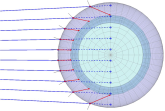2 min read
Dr. Luis Zea is a co-author in an article in npj Microgravity titled “Biofilm formation of Pseudomonas aeruginosa in spaceflight is minimized on lubricant impregnated surfaces” published Aug. 16, 2023.
Significance
Biofilms are communities of microbes attached to each other and to surfaces that can cause damage to materials either directly by using it as food, or indirectly via their metabolic byproducts. On Earth, biofilms are associated with 65% and 80% of infectious and chronic diseases, respectively. Materials can profoundly influence biofilm growth, and it is possible to design surfaces that either prevent microbial adhesion or that have antimicrobial properties. Microgravity experiments showed that a lubricant impregnated surface inhibited biofilm formation and it was even greater in microgravity. The lubricant impregnated surface seemed to prevent the first stage of biofilm formation: cell attachment. However, more tests and analysis are needed to fully understand the mechanisms behind this phenomenon.
Abstract
The undesirable, yet inevitable, presence of bacterial biofilms in spacecraft poses a risk to the proper functioning of systems and to astronauts’ health. To mitigate the risks that arise from them, it is important to understand biofilms’ behavior in microgravity. As part of the Space Biofilms project, biofilms of Pseudomonas aeruginosa were grown in spaceflight over material surfaces. Stainless Steel 316 (SS316) and passivated SS316 were tested for their relevance as spaceflight hardware components, while a lubricant impregnated surface (LIS) was tested as potential biofilm control strategy. The morphology and gene expression of biofilms were characterized. Biofilms in microgravity are less robust than on Earth. LIS strongly inhibits biofilm formation compared to SS. Furthermore, this effect is even greater in spaceflight than on Earth, making LIS a promising option for spacecraft use. Transcriptomic profiles for the different conditions are presented, and potential mechanisms of biofilm reduction on LIS are discussed.


